Buddhist Stupas in Astrology. A comparative study on the astrology and astrogeography of Buddhist spiritual art and architecture.
Related articles: An astrogeographical typology of monolithic domes, Shwedagon Pagoda in Myanmar, The Mahabodhi Temple in Bodhgaya, A Monumental Buddha Maitreya Statue in Scorpio, The “Spring Temple Buddha”, The Emerald Buddha, The Porcelain Pagoda of Nanjing, An astrogeographical history of skyscrapers, The Great Pyramid of Giza, Samye Gompa the oldest monastery in Tibet, The Longmen Grottoes
Buddhist Stupas in Astrology
Stupas originated as pre-Buddhist tumuli (burial mounds), in which ascetics were buried in a seated position called chaitya.
A classification and explanation of 8 different designs of Tibetan stupas can be found here.
Ancient Stupas
Ramabhar Stupa – Gautama Buddhas Burial Mound
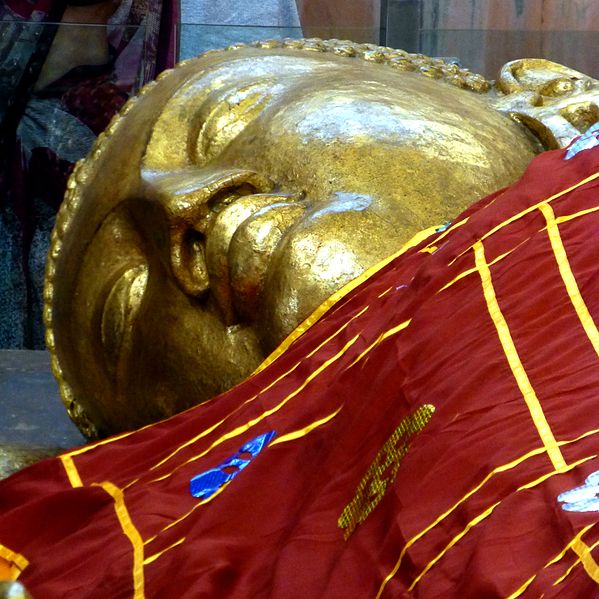
ph: Photo Dharma, ccbysa2.0
The town of Kushinagar is believed to be the place where Gautama Buddha attained Parinirvana after his death. The Ramabhar Stupa is said to have been built over his cremation ground.

Astrogeographical position of Ramabhar Stupa for morphogenetic field level 4 which describes the energetical topics, atmosphere and function of the stupa: the site of Ramabhar Stupa is located in the combination of dynamic, male fire sign Aries the sign of action, new starts, warfare, mobilization, fighting with mystic, spiritual water sign Pisces the sign of the unconscious, invisible, unknown, unspeakable, imagination, mystification, the other world and of re-connection with the spiritual plane. The position in fire sign Aries the sign of action, speed, new starts and of unicellular beings is a frequent and possibly symptomatic resonance factor for graveyards – especially when combined with one of the three water signs.
The Paranirvana Temple at Kushinagar
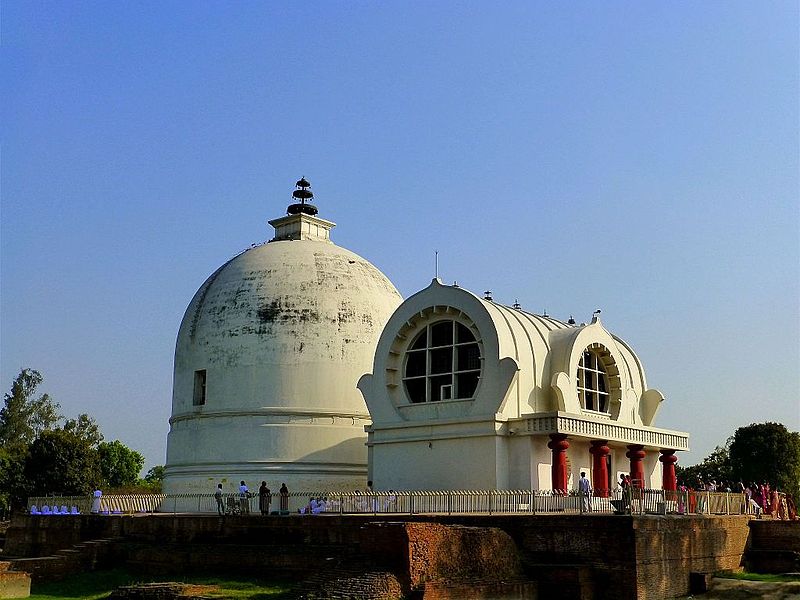
ph; Photo Dharma, ccbysa2.0
Astrogeographical position of the Paranirvana Temple for morphogenetic field level 4 which describes the energetical topics, atmosphere and function of the temple: the Paranirvana Temple at Kushinagar is located in the combination of earth sign Taurus (market places, center of society) with water sign Scorpio (sculpting, imaging, iconography, tombs).
The shape of the stupa may be found to resemble a bunker (defensive aspect of Scorpio) or tomb (Scorpio as the sign of the underworld) rather than a monument built for the topic of grounding cosmic, heavenly, spiritual energies as in the case of the later stupas built in air signs. The Taj Mahal in Agra built as a burial chamber is located in the same sign combination reflecting the form of the dome as a representation of a mushroom.
Ruwanwelisaya
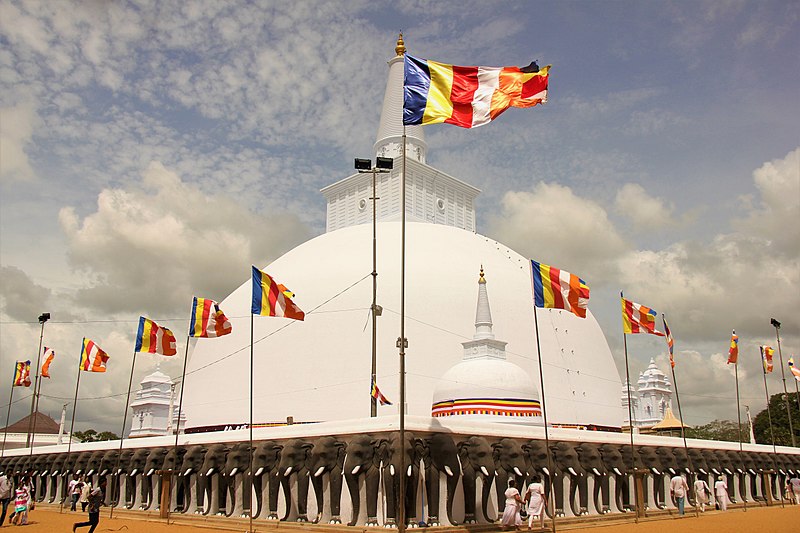
ph: AKS.9955, ccbysa4.0
The Ruwanwelisaya is a stupa and a hemispherical structure in the ancient sacred City of Anuradhapura (Sri Lanka) built by King Dutugemunu king of the Anuradhapura Kingdom in 140 B.C. for important relics of Gautama Buddha. Today the stupa is 103 m tall and with a circumference of 290 m. The original stupa had been about 55 m in height. The Kaunghmudaw Pagoda in Sagaing, Myanmar is modelled after this stupa.
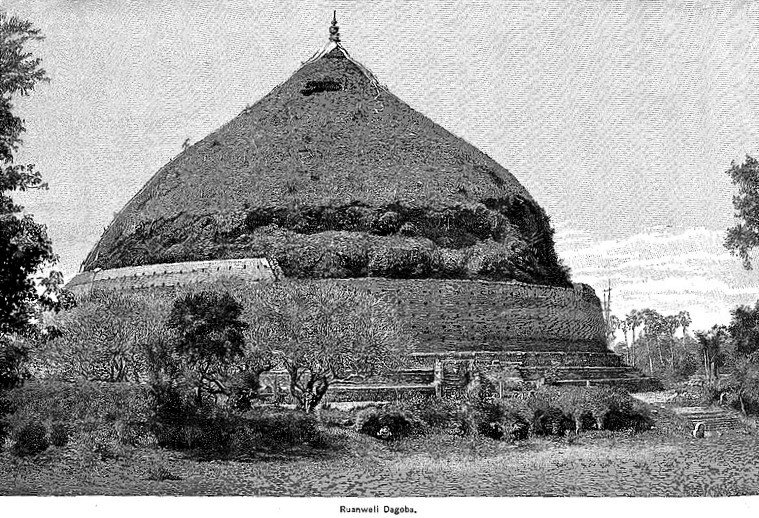
Astrogeographical position for morphogenetic field level 4 which describes the energetical topics, atmosphere and function of the stupa: the construction site has one coordinate in creative, innovative, spiritual air sign Aquarius sign of the sky, heaven, paradise, flying, self-liberation, re-connection with the fuller potentials of mankind, connecting earth and sky and early skyscrapers. Aquarius explains the function of the stupa as a monument to reaching out for heaven and cosmic realms, self-liberation and of an acupuncture needle dedicated at channeling energies from the nervous system of the landscape in the direction of the sky and cosmic energies coming in from heaven into the ground.
The 2nd coordinate stretches from dynamical male fire sign Aries sign of action, speed, erection, mobilization, sports, warfare, fighting, beginnings and starting projects into solid, fixed earth sign Taurus sign of the earth, grounding, roots, agriculture, food, possession of land, market places, money and the center of society.
For a deeper study of the topics of buildings that handle the issues of connecting earth and sky and of grounding cosmic energies see my article: Lying or Flying – The Leaning Tower of Pisa.
The Great Stupa of Sanchi
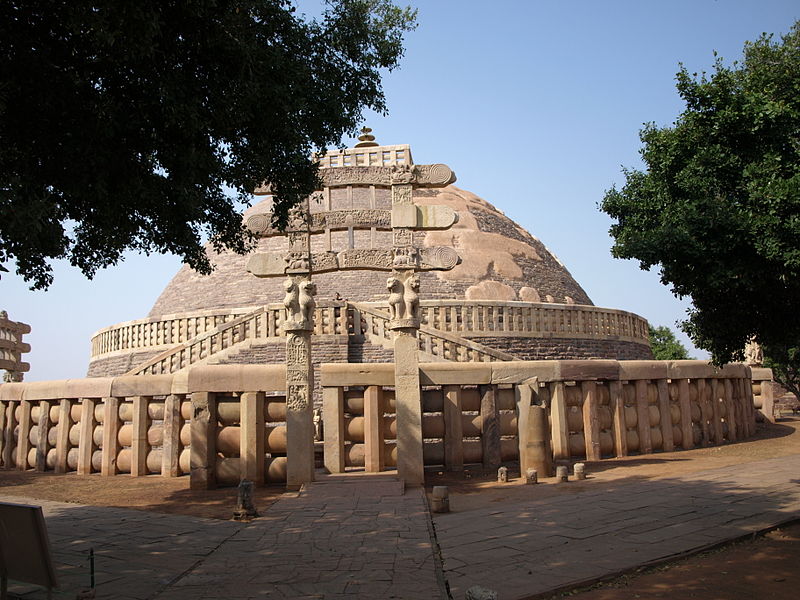
The Great Stupa at Sanchi is one of the oldest stone structures in India. It was originally commissioned by the emperor Ashoka in the 3rd century BCE. Its nucleus was a simple hemispherical brick structure built over the relics of Gautama Buddha. It was crowned by the chhatri, a parasol-like structure symbolizing high rank. Sanchi is the center of a region with a number of stupas, all within a few miles of Sanchi,
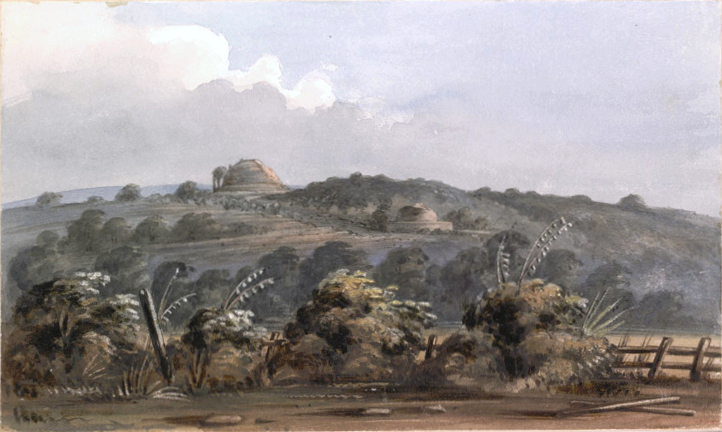
19th century painting by Frederick Charles Maisey.
Astrogeographical position for morphogenetic field level 4 which describes the energetical topics, atmosphere and function of the stupa: the construction site of the Great Stupa of Sanchi has one coordinate right on the divide between solid, conservative earth sign Capricorn the sign of mountain tops stability, hardware, governments, state cult, rules and regulations and creative, innovative air sign Aquarius sign of the sky, heaven, paradise, inspiration, self-finding. The position between Capricorn and Aquarius relates to the topic of connecting earth and sky.
The 2nd coordinate of the stupa is located on the first degrees of air sign Gemini the sign of road crossings, signposts, symbols, language, communication, passing information, learning and teaching. Gemini relates to the function of the stupa as a medium of passing information.
Bawbawgyi Stupa – the prototype of Burmese stupas
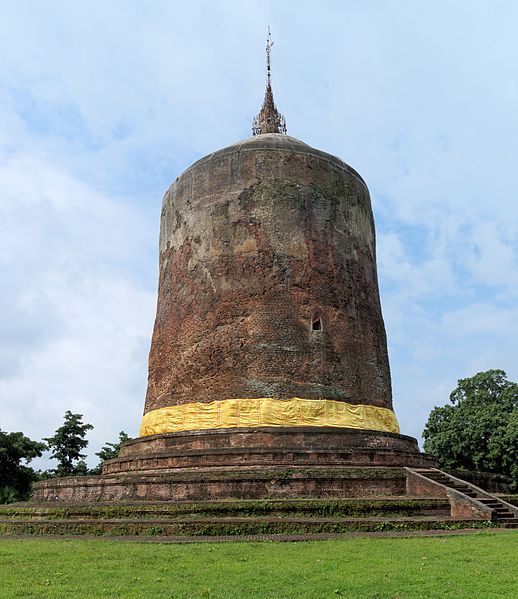
Bawbawgyi Stupa is a Buddhist stupa at the site of the former city of Sri Ksetra constructed during the Pyu period in the 5th century. It is one of the oldest Buddhist structures in Myanmar. The stupa is in excellent structural condition, having miraculously survived a number of major earthquakes.
Astrogeographical position for morphogenetic field level 4 which describes the energetical topics, atmosphere and function of the stupa: one coordinate is on the first degrees of creative, innovative, spiritual air sign Aquarius sign of the sky, heaven, paradise, flying, self-liberation, re-connection with the fuller potentials of mankind, connecting earth and sky and early skyscrapers. Aquarius explains the function of the stupa as a monument to reaching out for heaven and cosmic realms, self-liberation and of an acupuncture needle dedicated at channeling energies from the nervous system of the landscape in the direction of the sky and cosmic energies coming in from heaven into the ground.
The 2nd coordinate is in self-protective earth sign Virgo sign of Hinduism and yoga culture, celibacy, monk-hood, reason, health, medicine, gardening, plants, protection of nature, science of agriculture, harvesting and of storing goods.
Phra Pathom Chedi
Phra Pathom Chedi at Wat Phra Pathom in Nakorn Pahom is the tallest stupa in Thailand. The top of its spire reaches 120.45 meters with the base circumference of 235.50 meters. It is traditionally considered to represent the oldest stupa in Thailand with its construction started in 193 BCE.

ph: Preecha.MJ, ccbysa4.0
Astrogeographical position for morphogenetic field level 4 which describes the energetical topics, atmosphere and function of the stupa: one coordinate is located in mystic, spiritual water sign Pisces the sign of mystification, imagination, meditation, deep relaxation, music, temples, art and re-connection with the spiritual plane.
The 2nd resonance coordinate is located right on the cardinal divide of the autumn equinox between earth sign Virgo the sign of Hinduism and yoga culture, celibacy, monk-hood, reason, health, medicine, gardening, plants, protection of nature, science of agriculture, harvesting and air sign Libra the sign of openness, angels, service, harmony, balance, beauty, relationship, decoration and stage presentation. The position on a cardinal divide emphasizes the function of the stupa for harmonizing the flow of energies in the nervous system of the landscape through the aesthetical presentation and the image of beauty and harmony send out by this stupa. Libra is also an astrogeographical factor at the site of the important Shwe Dagon Pagoda in Yangun.
Boudanath Stupa at Kathmandu
Its massive mandala makes Boudhanath stupa one of the largest spherical stupas worldwide. It is assumed to have been built in the 5th or 6th century by the Kings of Nepal.
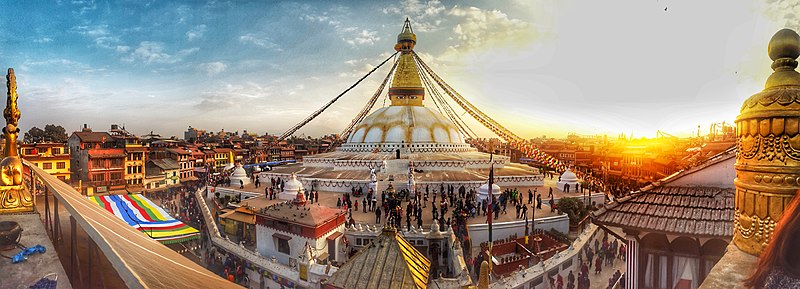
Astrogeographical position for morphogenetic field level 4 which describes the energetical topics, atmosphere and function of the stupa: One resonance coordinate is located right on the cardinal divide of the autumn equinox between earth sign Virgo the sign of Hinduism and yoga culture, celibacy, monk-hood, reason, health, medicine, gardening, plants, protection of nature, science of agriculture, harvesting and air sign Libra the sign of openness, angels, service, harmony, balance, beauty, relationship, decoration and stage presentation. The position on a cardinal divide emphasizes the function of the stupa for harmonizing the flow of energies in the nervous system of the landscape through the aesthetical presentation and the image of beauty and harmony send out by this stupa. Libra is also an astrogeographical factor at the site of the important Shwe Dagon Pagoda in Yangun.
The 2nd coordinate is on the first degrees of creative, innovative, spiritual air sign Aquarius sign of the sky, heaven, paradise, flying, self-liberation, re-connection with the fuller potentials of mankind, connecting earth and sky and early skyscrapers. Aquarius explains the function of the stupa as a monument to reaching out for heaven and cosmic realms, self-liberation and of an acupuncture needle dedicated at channeling energies from the nervous system of the landscape in the direction of the sky and of cosmic energies coming in from heaven into the ground.
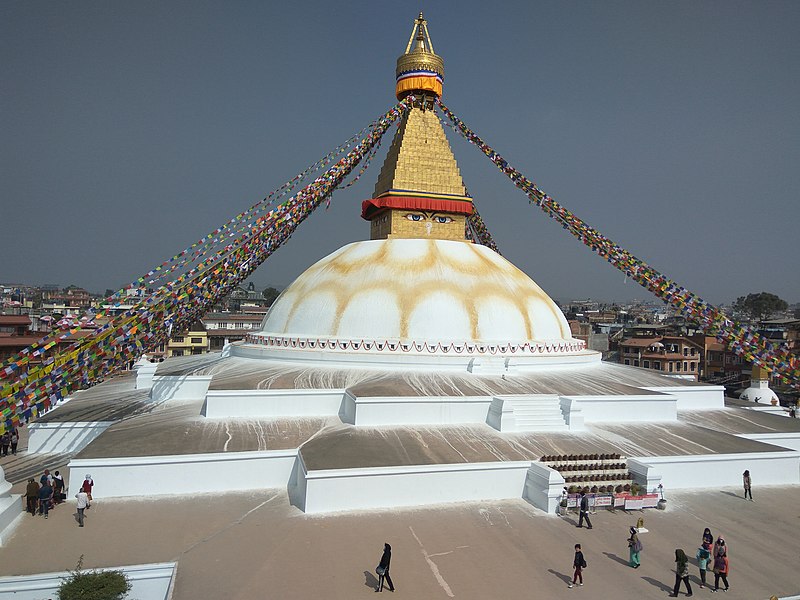
Dhamek Stupa in Sarnath
Dhamek Stupa (Stupa of the reign of Dharma) is a massive 43.6 meters tall 28 meters diameter stupa located at Sarnath near Varanasi where Gautama Buddha first taught the Dharma and where the Buddhist Sangha (community of monks) came into existence through the enlightenment of Kondanna.
The Dhamek Stupa was built in 500 CE to replace an earlier structure commissioned by King Ashoka in 249 BCE to commemorate the Buddha’s activities at Sarnath. Ashoka built stupas that enshrined small pieces of calcinated bone and other relics of Gautama Buddha and his disciples. An Ashoka pillar with an edict engraved on it stands near the site.
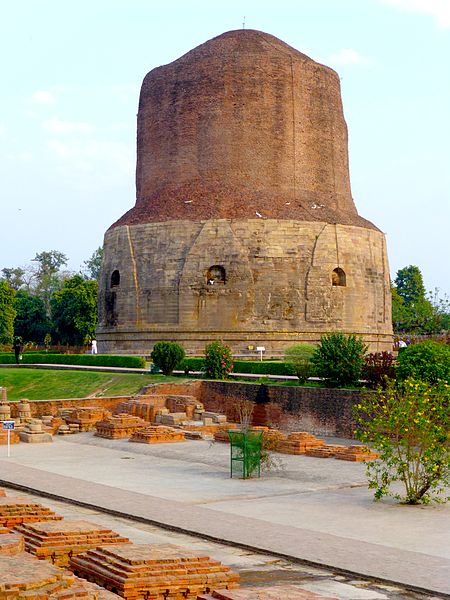
Astrogeographical position for morphogenetic field level 4 which describes the energetical topics, atmosphere and function of the stupa: one resonance coordinate of the stupa is located on the very last degrees of air sign Gemini the sign of road crossings, signposts, symbols, language, communication, passing information, learning and teaching. The function of the stupa is therefore to be examined as aiming at representing and spreading information about Buddhism. The fact that the stupa is located right next to the cardinal divide of the summer solstice at 0° (IC) in water sign Cancer explains its function as an acupuncture needle aimed at stabilizing the information of emotional independence, self-centering and fertility of the land and its inhabitants.
The 2nd coordinate is located in solid, fixed earth sign Taurus sign of the earth, grounding, roots, agriculture, food, possession of land, market places, money and the center of society. The choice of a place located in the sign of materialism indicates the aim of grounding Buddhism in the center of society.
The Great Stupa of Amaravathi

ph: Nandign, ccbysa3.0
The great stūpa at Amarāvathī was built in phases between the third century BCE and about 250 CE at Amaravathi village, Guntur district, Andhra Pradesh, India. The important sculptures from the site are now in a number of museums in India and abroad.
Astrogeographical position for morphogenetic field level 4 which describes the energetical topics, atmosphere and function of the stupa: one coordinate is located in service orientated, aristocratic air sign Libra the sign of openness, angels, service, harmony, balance, beauty, relationship, decoration and stage presentation.
The 2nd coordinate is in self-protective sign earth sign Virgo sign of Hindu and yoga culture, celibacy, monk-hood, self-cleaning, reason, health, medicine, gardening, plants, protection of nature, science of agriculture, harvesting and of storing goods.
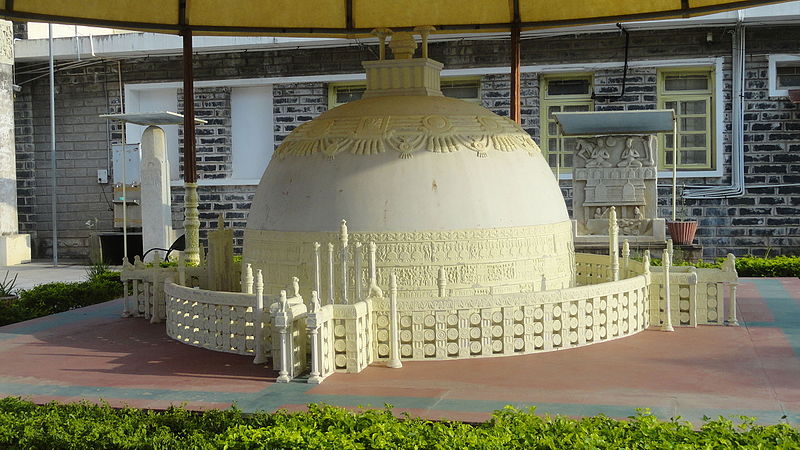
ph: Bhaskaranaidu, ccbysa4.0
Swayambunath Stupa in Kathmandu
Swayambhunath is among the oldest religious sites in Nepal the homeland of Gautama Buddha. It is assumed to have been founded by the great-grandfather of King Mānadeva (464-505 CE), King Vṛsadeva, about the beginning of the 5th century CE. A first temple on the hill had been founded by King Ashoka.
The stupa consists of a dome at the base, above which is a cubical structure painted with eyes of Buddha looking in all four directions.

As the astrogeographical resonance coordinates of the stupa are located on the cardinal divides of the summer and of the winter solstices the sanctuary has a strong resonance with the natural solar year and is among other function to be examined as a sun temple and temple of light.
Astrogeographical position for morphogenetic field level 4 which describes the energetical topics, atmosphere and function of the monument: similar to the Dhamek stupa one coordinate is located on the last degree of air sign Gemini the sign of road crossings, signposts, symbols, language, communication, passing information, learning and teaching. The function of the stupa is therefore to be examined as aiming at representing and spreading information about Buddhism. The fact that the stupa is located right next to the cardinal divide of the summer solstice at 0° (IC) in water sign Cancer explains its function as an acupuncture needle aimed at stabilizing the information of emotional independence, self-centering and fertility of the land and its inhabitants.
The 2nd coordinate of Swayambunath Stupa is located on a cardinal divide too. It falls right on the degree of the winter solstice between dynamic fire sign Sagittarius the sign of shamanism, preaching, healing, fire rituals, mental knowledge, thinking, understanding, preaching, mental stimulation of watching, time-measurement, initiation awareness about cyclic development and solid, conservative earth sign Capricorn the sign of hard rock material, mountains, hardware, control, rules and regulations, government institutions and overlooking the surroundings.
“There is a large pair of eyes on each of the four sides of the main stupa which represent Wisdom and Compassion. Above each pair of eyes is the third eye. It is said that when Buddha preaches, cosmic rays emanate from the third eye which acts as messages to heavenly beings so that those interested can come down to earth to listen to the Buddha. The hellish beings and beings below the human realm cannot come to earth to listen to the Buddha’s teaching, however, the cosmic rays relieve their suffering when Buddha preaches.” (from the wiki article)

The Kumbum of Palcho Monastery and the ideal of illumination in Sagittarius with Aquarius
The famous Kumbum (“one hundred thousand holy images”) of Palcho Monastery at Gyantse, Tibet was founded by a Gyantse prince in 1427 – a year of the fire sheep. The 35 metres high stupa-like building is surmounted by a golden dome and contains 77 chapels which line its walls. The Kumbum of Gyantse is a three-dimensional mandala meant to portray the Buddhist perspective on the cosmos.
Like other mandalas (circle within a square) the concept of the Kumbum is to enable devotee to take part in the Buddhist perception of the universe. It can depict one’s potential as one moves through it. Mandalas are meant to aid an individual on the path to enlightenment. The Kumbum holds a vast number of images of deities throughout its structure with Vajradhara the cosmic Buddha, at the top.

ph: Alberrosidus, ccbysal3.0
Astrogeographical position for morphogenetic field level 4 which describes the energetical topics, atmosphere and function of the the Kumbum of Palcho Gompa: the building has one coordinate in highly dynamic fire sign Sagittarius the sign if initiation, travelling, thinking, searching, observing, hunting, philosophy and of aims. Sagittarius is symptomatic of the a mandala or labyrinth dedicated at experiencing the quest of finding the path to the
The 2nd coordinate is located in creative innovative, spiritual air sign Aquarius the sign of self-finding, self-liberation, leaving the past behind and of re-connection with the fuller potentials of human. Aquarius explains the function of the stupa as a monument to reaching out for heaven and cosmic realms, self-liberation and of an acupuncture needle dedicated at channeling energies from the nervous system of the landscape in the direction of the sky and of cosmic energies coming in from heaven into the ground.
The combination of Aquarius with Sagittarius represents the astrological archetype of the ideal of searching the path for illumination.
Pha That Luang Stupa
Pha That Luang is a gold-covered stupa generally regarded as the most important national monument and national symbol of Laos. It is located in the center of the capital Vientiane, The first stupa at the site was built in the 3rd century BCE for sacred relics of Gautama Buddha. The relics are assumed to have been brought to Laos by Buddhist monks sent by Emperor Ashoka when he converted the state cult of his Mauryan Empire to a “monotheist” Buddhism some time between 260 and 250 BCE.
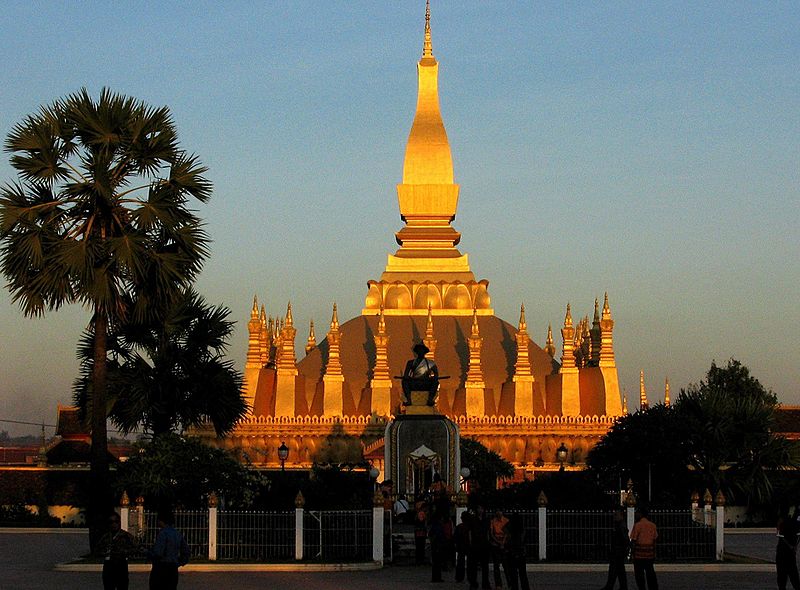
Astrogeographical position of Pha That Luang Stupa for morphogenetic field level 4 which describes its energetical topics, atmosphere and function: Pha That Luang Stupa has one coordinate in creative, innovative air sign Aquarius (sky, heaven, self-liberation, inspiration, cosmic plane, stars, innovation).
The 2nd coordinate is located right in between dynamic male fire sign Aries (action, new starts, mobilization) and solid fixed earth sign Taurus (market places, money, agriculture, food, center of society, possession of land) indicating the topic of connecting earth and sky while starting the new project of introducing Buddhism to the Laos- Siam region.
The 108 Stupas near Qingtongxia
The One Hundred and Eight Stupas installation is an array of one hundred and eight Buddhist stupas (also called dagobas) on a hillside on the west bank of the Yellow River at Qingtongxia in the Ningxia Autonomous Region of China. The stupas were originally constructed during the Western Xia Empire (1038 – 1227).
“The 108 stupas are arrayed in a triangular formation up the side of a hill, facing southeast, overlooking the Yellow River. There is one large stupa at the apex of the triangle, with a Buddhist hall behind it, and below that are eleven rows of one hundred and seven smaller stupas on brick platforms of increasing width running down the hill. The number of stupas on each level is: 1, 3, 3, 5, 5, 7, 9, 11, 13, 15, 17, 19. The reason why there are a 108 stupas is that the number 108 is a sacred number in Buddhism, for example Buddhist rosary beads number 108. Odd numbers are also considered auspicious in Buddhism (so pagodas always have an odd number of storeys), which is why the number of stupas on each row is an odd number.” (from the wiki article)
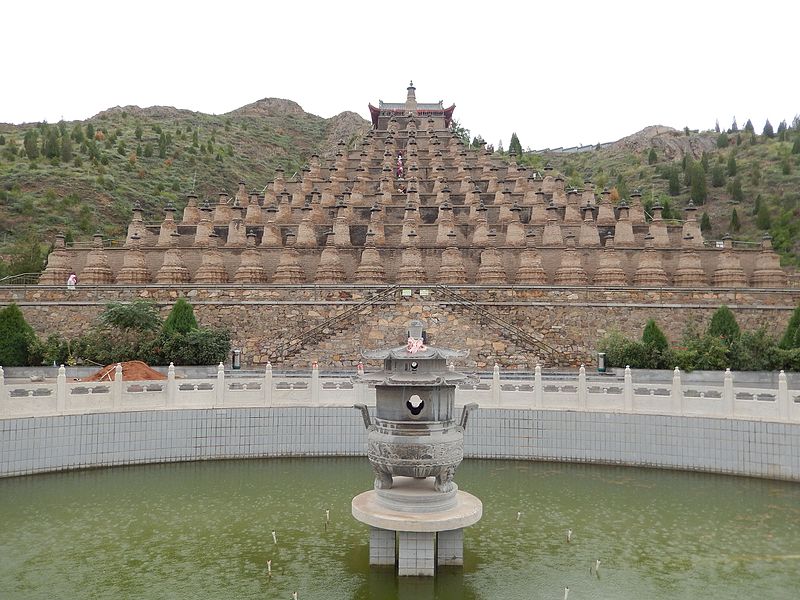
ph: BabelStone, ccbysa3.0
Astrogeographical position for morphogenetic field level 4 which describes the energetical topics, atmosphere and function of the monument: one coordinate is on the first degrees of creative, innovative, spiritual, open air sign Aquarius sign of the sky, heaven, oxygen, strong winds, rain, paradise, flying, self-liberation, re-connection with the fuller potentials of mankind, abstraction, globalization, connecting earth and sky and early skyscrapers. Aquarius explains the function of the stupa installation as a monument to reaching out for heaven and cosmic realms, self-liberation and dedicated at channeling energies from the nervous system of the landscape in the direction of the sky and of cosmic energies coming in from heaven into the ground.
The 2nd coordinate is in Aquarius` opposite sign – self-centered, magnetic, royal fire sign Leo sign of the sun, light, power stations, kingdom, magnificence, luxury and an indication of a temple site dedicated to displaying a maximal amount of glorification of the magnificence of the royal state cult. The glorification is through the sheer quantity of installed acupuncture or “lithopuncture” sculptures. The installation may be understood to represent the idea of a power station or a battery of powerful arms.
The parallel with the astrogeographical position of Amarna, the city built for the introduction of the first monotheist state-cult in a developed, multi-ethnic society explains the function of the 108 stupas as a monument dedicated to the monopolization of a complete set of single aspects of the supreme in religious state cult. Compare my article: Aquarius and Leo – The Capital of the Sun God Aten.
The Hierarchy of the 1 + 107 in Leo and the destruction of individuality as the center of Chinese culture, state cult and national field
The installation of a hierarchy among the 108 stupas being located in fire sign Leo resonates with Leo`s ideal of absolutist centralism, royalty and superiority of the Chinese Kings (today: Communist Party) as the natural born representative of the supreme. The control of the Royal Chinese Empires to the One single aspect has to stand above all other elements thus making the 107 minor aspects of identities members of a superior elite that is being drawn to the one and only center. The monument so appears to suggest that the focus on the ideal of a hierarchical order is the central essence of Buddhism overwriting the actual issue of inner, spiritual self-exploration and self-liberation of human individuals.
This element so replaces the core issues of Buddhism through a symptomatic documentation of an absolutist and monotheist approach to the state cult which is so typical for the degradation, abolition and prohibition of individuality and individualism in Chinese culture. It also reflects the fact that the center of the national morphic field of China is located in the combination of ornamental fire sign Sagittarius the sign of mental infiltration through religious propaganda with fire sign Leo the sign of light itself in such a way that individuality and individualization are reduced to their function as ornaments of the worship of an absolutist center. Such a sculpture battery of hierarchically organized monotony can not be imagined to exist in India the land of the origin of Buddhism.
Modern Stupas
National Memorial Chorten in Timphu, Bhutan
The Thimphu Chorten or Memorial Stupa at Thimphu the capital of Bhutan Thimphu was built in 1974 to honor the third Druk Gyalpo, Jigme Dorji Wangchuck (1928–1972). The stupa was conceived by Thinley Norbu Rinpoche (1931–2011) according to the Nyingma tradition of Tibetan Buddhism. It consists of a classical stupa, with a pyramidal pillar crowned by a crescent moon and sun. The feature that is distinct here is the outward flaring of the rounded part to give the shape of a vase (a pyramidal shape), unlike a dome shape. The chorten depicts larger than life size images of wrathful deities with their female consorts in large numbers, and many in explicit Yab-Yum sexual poses (one count puts the number of such images at 36).
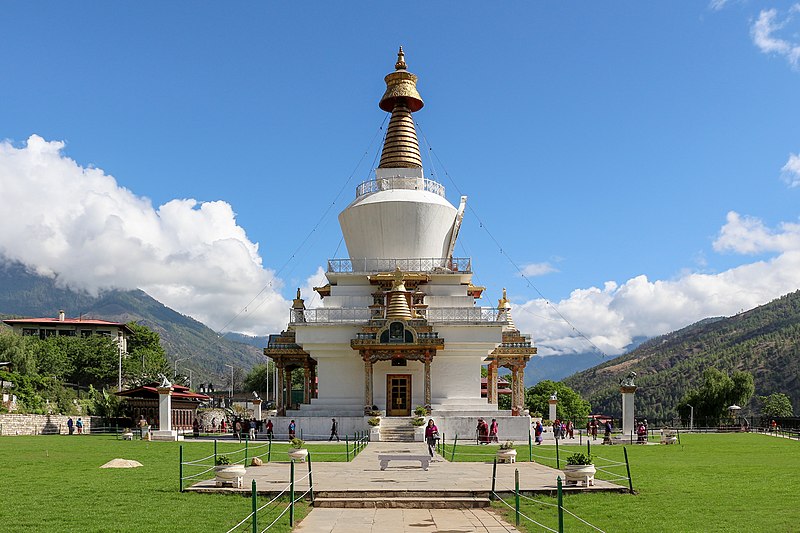
ph: Bernard Gagnon, ccbysa4.0
Astrogeographical position for morphogenetic field level 4 which describes the energetical topics, atmosphere and function of the monument: creative, innovative, spiritual, open air sign Aquarius sign of the sky, heaven, oxygen, strong winds, rain, paradise, flying, self-liberation, re-connection with the fuller potentials of mankind, connecting earth and sky and early skyscrapers. Aquarius explains the function of the stupa as a monument to reaching out for heaven and cosmic realms, self-liberation and dedicated at channeling energies from the nervous system of the landscape in the direction of the sky and of cosmic energies coming in from heaven into the ground.
The 2nd coordinate is located right in between dynamic male fire sign Aries (action, new starts, mobilization) and solid fixed earth sign Taurus (market places, money, agriculture, food, center of society, possession of land) indicating the topic of supporting territorial defense and expansion.
The combination of Aquarius with Taurus stands for connecting earth and sky.
A Padmasambhava sculpture in the form of a stupa
The statue of Padmasambhava in the form of Guru Nangsi Zilnoen built in Takela, Lhuntse in 2015 is dedicated to bringing peace and harmony to the world as prophesied by Lord Buddha and the Great Dzogchen masters. The statue is 148 feet tall including a 30 foot high lion throne.

ph: Vikramjit KAkati, ccbysa4.0
Astrogeographical position for morphogenetic field level 4 which describes the energetical topics, atmosphere and function of the monument: the site is located in service orientated air sign Libra sign of harmony, balance, peace, justice, symmetry, relationships, love, marriage, empathy beauty and of decoration.
The 2nd coordinate is located right in between dynamic male fire sign Aries (action, new starts, mobilization) and solid fixed earth sign Taurus (market places, money, agriculture, food, center of society, possession of land) indicating the topic of supporting territorial defense and expansion.
Chua Buu Long Pagoda
Chua Buu Long Pagoda near located near the Dong Nai River in Ho Chi Minh City, Vietnam was built in 1942 in the form of an idealization of ornamental harmony in what seems like an early Disneyland type of design.
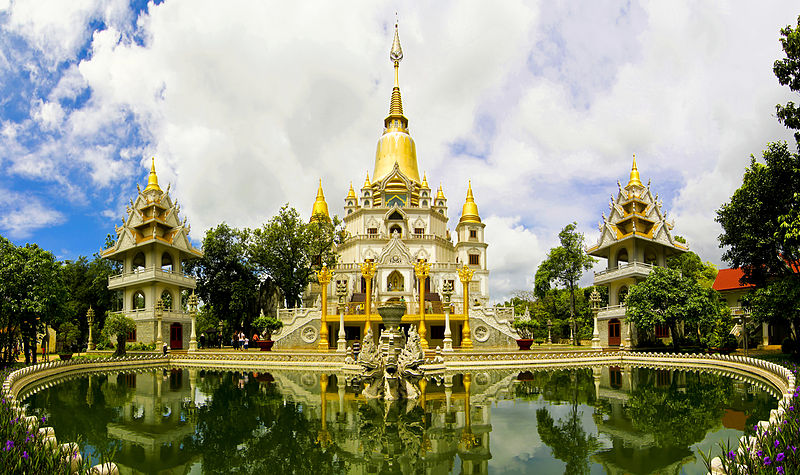
ph: Quốc Anh Võ, ccbysa4.0,
Astrogeographical position for morphogenetic field level 4 which describes the energetical topics, atmosphere and function of the monument: the site has one coordinate in dynamical fire sign Sagittarius indicator of the extreme emphasis on style, design, fashion, ornamentation and submission of all single feature under the composition of the overall design. Typical for Sagittarius is that the completeness of the design (aim of success) is more important than the authenticity of the methods (the path) used for the purpose. The arrowhead on top of the stupa-shaped pagoda directly resonates with the role of Sagittarius as the sign of the archer, arrow and bow.
The 2nd coordinate of the construction site being on the first degrees of solid, conservative earth sign Capricorn the zodiac degrees of the government, king, throne or pulpit from which reality is perceived indicates that the construction of the pagoda was realized to classify an abstract classical example for the hardware or skeleton for a state cult version of the ideal Buddhist stupa pagoda.